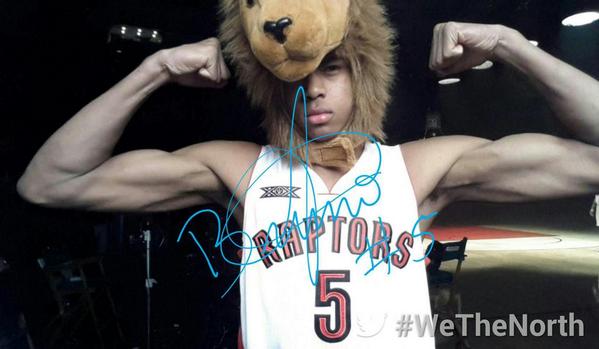If you haven’t been paying attention to the Toronto Raptors’ (largely untelevised) preseason, chances are you haven’t gotten an up-close look at Bruno Caboclo yet. Sure, there was Summer League, where he averaged 11.4 points in 26 minutes over five games, but he’s been playing against actual NBA competition the past two weeks.
The returns are actually somewhat encouraging, even if the raw numbers aren’t.
He’s averaged 4.3 points on 37.5 percent shooting in four appearances, he’s 4-of-9 from downtown, he’s dunked, he blocked a shot (incredulously uncredited), and he’s notched three steals. If we’re being totally honest, he still looks a babe on offense. When he’s hit the floor, he’s primarily stood in the corner and hasn’t been heavily involved in the running of actual plays. An NBA offense is not an easy thing to pick up in one training camp, and head coach Dwane Casey has understandably simplified Caboclo’s role. Defensively, it would be hard not to be disruptive with an 11-foot wingspan (I can’t confirm this is an accurate eyeball measurement). He can enter passing and driving lanes while recovering quickly, and while his instincts will take a while to come along, you wouldn’t be terrified of him being exposed in short stints during the regular season.
In short, he hasn’t looked entirely out of place. Not as much as you’d expect from a famously “two years away from being two years away” 19-year-old who only knew the name of a single active NBA player, anyway. The learning curve is expected to be substantial, and patience will be paramount.
When the season begins, it’s possible Caboclo falls out of the fanbase’s consciousness. He’s probably going to be inactive more often than not, and even when in uniform he’ll probably see run only in garbage time. It would be surprising if he topped the 146 minutes Dwight Buycks played last season.
That’s an unfortunate necessity of rooting for an incredibly raw rookie on a team with designs on a high playoff seed. This club is no longer in the business of trading wins for development, and anything they do to bring Caboclo along will have to fit within the larger context of being a playoff team.
What that means is that Caboclo’s development will lean heavily on the value of practices and instruction from the coaching staff. For a player as raw as Caboclo is, that’s not the worst reality – he has a great deal to learn still, from physical fundamentals to just learning more about the game of basketball. A de facto redshirt season at age 19 is still a major and expeditious step in his development. The team just needs to be careful that he doesn’t get lost in the shuffle as the schedule ramps up and full practices become somewhat less frequent.
For 17 NBA teams, this wouldn’t be all that big a deal. For more than half the league, sending a player like Caboclo to the D-League is a realistic and potentially fruitful option. With an exclusive affiliation, those 17 teams would be afforded the opportunity to send Caboclo down to their farm club, where he would receive instruction from coaches and staff that the parent team has put in place. Come game time, the parent club could manage his minutes and role from afar, trusting that an organization with staff all their own would have the interests of the team and player foremost in mind.
For the Raptors and 12 other clubs, that option is more tenuous. Toronto shares the Fort Wayne Mad Ants – and therefore, the best mascot in sports – with the 12 other teams who don’t have an exclusive D-League affiliation.
That doesn’t entirely rule out the value of a D-League assignment for Caboclo (or Bebe Nogueira, for that matter). It would still represent more in-game playing time than he’s likely to get with the Raptors, after all. Unfortunately, the Raptors would have far less control of the situation than is ideal. Fort Wayne has to keep the interests of 13 teams in mind, and juggle development time for assignees from all of those parent clubs. That’s a difficult task, and it’s unclear exactly how much the Raptors will trust the Mad Ants with their No. 20 overall pick.
I’ve been beating the D-League drum for a long time around these parts, and it’s quite unfortunate that the previous management regime didn’t see enough value in the development system to be an early adopter. The Raptors appear to be moving in the direction of securing an exclusive affiliate, but it’s going to be a year or two later than the point at which it may have held the most value.
At media day, I asked general manager Masai Ujiri if the organization regretted being slow to the punch with respect to the D-League. It was a poorly phrased question – Ujiri scoffed at the word “regret” before kindly answering my actual inquiry – considering the timing of the front office changeover. Still, it was retrospectively short-sighted of the previous regime, and Ujiri expressed that the franchise has an interest in exploring that potential competitive edge further moving forward.
With Caboclo on a multi-year development path, not having exclusive control of a D-League affiliate may not be a big deal for this season. Caboclo has far enough to come that a redshirt rookie season spent learning in the gym and by watching, with occasional playing time scattered in, wouldn’t seem anything close to a wasted year. A sophomore season split between heavier run in the D-League and spot duty with the big club would then represent a nice step forward, with an aim toward Caboclo contributing in a meaningful way in 2016.
This is all just thinking aloud, and it may very well be a case where Caboclo’s development dictates his next steps more than any predetermined plan, but it will be interesting to see how the team handles O Escolhido when camp breaks.



